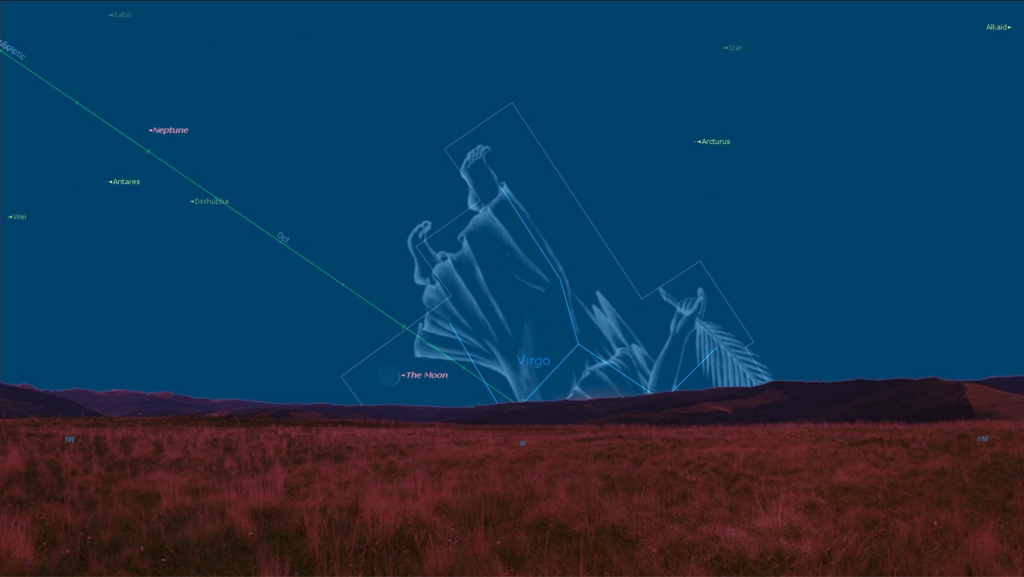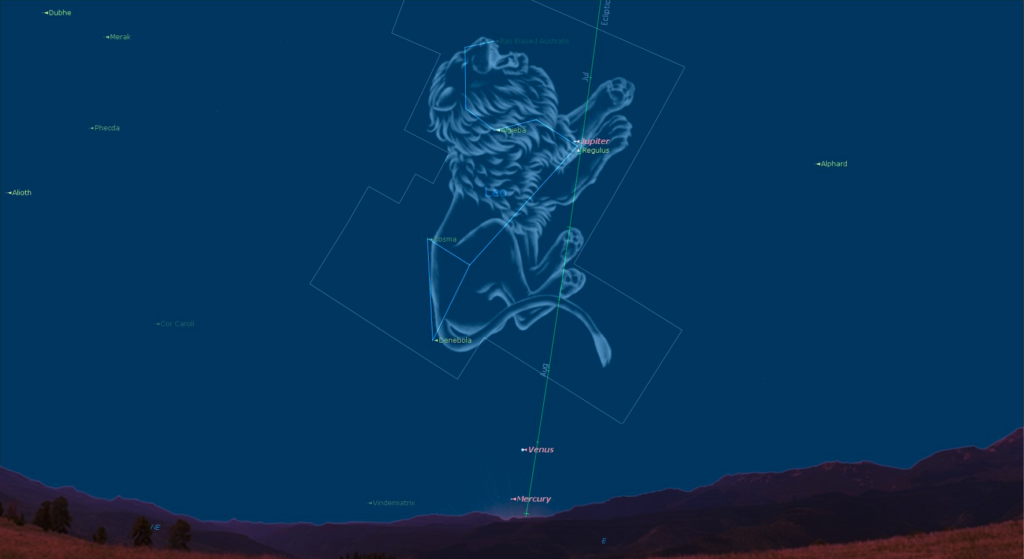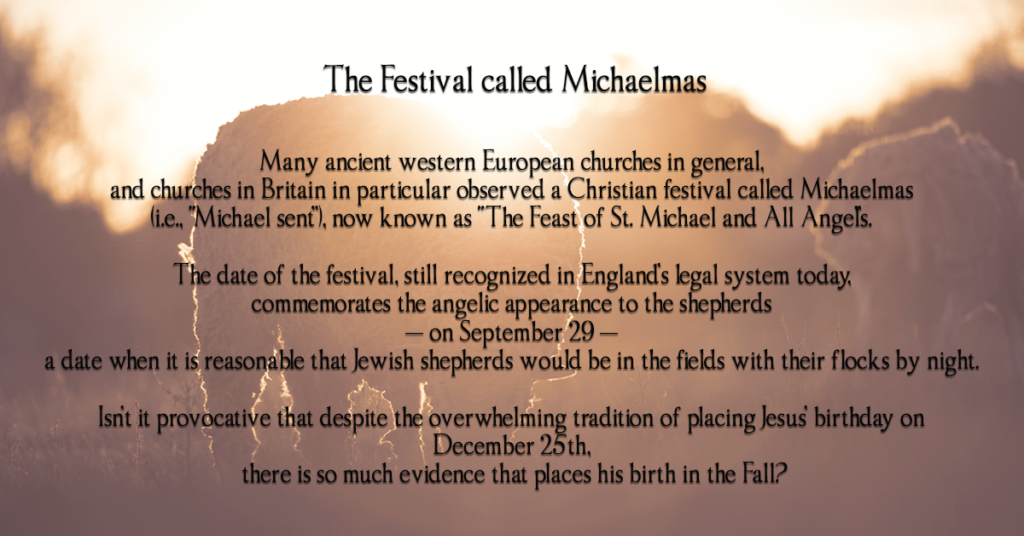
(Pictured above the horizon for clarity.)
In the featured image, Virgo is represented above the horizon before the sunsets which is technically not possible. This is to help the viewer grasp what the whole constellation looks like even though it is only partially visible once the sun has set. This is explained as part of the study.
[All images Copyright (C) Starry Night]
Introduction–
In certain circles strong debate over the correct date of the birth of Jesus of Nazareth still continues, but there is a subset of the biblical astronomy community that is quite settled on the issue. By correcting the date of Herod’s death, placing it in early 1 BC as opposed to the traditional but incorrect date of 4 BC, and then cross-referencing this with the “governorship of Publius Sulpicius Quirinius” (Luke 2:2), the “division of Abijah” (Luke 1:5), the “fifteenth year of Tiberius Caesar” (Luke 3:1–3), and the “decree from Augustus Caesar” (Luke 2:1) that went out in the summer of 3 BC, biblical scholars logically focus their attention on the fall of 3 BC. But the final piece of the puzzle and the one that really puts it over the top is the combined astronomical sign of Revelation 12:1 plus Genesis 49:10. Two witnesses—one from the Old Testament—one from the New.
And there appeared a great wonder in heaven; a woman clothed with the sun, and the moon under her feet, and upon her head a crown of twelve stars. [Revelation 12:1 KJV]
The scepter shall not depart from Judah, nor a lawgiver from between his feet, until Shiloh come; and unto him shall the gathering of the people be. [Genesis 49:10 KJV]
Many commentators continue to insist that the sign of Revelation 12:1/Genesis 49:10 is generic as opposed to specific, and therefore does not mark the birth of Christ. I respectfully disagree and here’s why—there are too many distinct details to this sign for it to be generic. This is a rare combination of details that can only occur every few thousand years at best. These details are…
- The woman clothed with the sun.
- The moon under her feet.
- The crown of twelve stars.
- The scepter is in Judah.
- The lawgiver is between his feet.
- The lawgiver will not depart from between his feet until Shiloh comes.
- All of this coincides with a Hebrew festival, specifically the Feast of Trumpets—the day of reckoning regnal years.
By the Mouth of Two Witnesses–
…by the mouth of two or three witnesses the matter shall be established. [Deuteronomy 19:15b NKJV]
Before we examine each of these details however, there is one significant point that has apparently been over-looked by many scholars and laymen alike with regard to biblical astronomy—connecting the sign in Revelation 12:1 with the sign in Genesis 49:10, both of which appeared in the sky at the birth of Christ. But here is the key—both signs were not visible in the sky at the same time. In order to “see” or “read” this complete sign, Revelation plus Genesis 49:10, one would need to engage (as ancient astronomers did) in both a morning and evening observation and then combine the two pictures into one mentally.
Now many will object and insist that both signs must be observable simultaneously to the naked-eye (known as NEO or naked-eye observation), but they are neglecting an important fact that was part and parcel of ancient astronomy.
The “morning” observation took place during the darkness before sunrise and then continued until the sun’s brightness occluded most other celestial objects. The “evening” observation worked in reverse. It began with the sun still above the horizon when most other celestial objects were still “invisible,” until the sun set enough for twilight to begin and these other celestial objects to start to become visible. When the sun is “in” a particular constellation however, that constellation by definition will only be partially visible at both sunrise and sunset—it is impossible to see the full constellation when the sun is in that constellation. This is important because the position of the sun “in” a constellation is a fundamental component of astronomical observation. In other words, observing partial signs (because of limited visibility caused by the sun) was not only common, but a foundational component of how astronomical observation works. Professional and even amateur astronomers would already be familiar with the outline of the constellations from observing them in total darkness. Then, when the time of year comes around that the sun is in that constellation, it is still recognizable even when only partially visible. This is standard procedure in celestial observation.
This is one of the keys that unlocks the sign of Revelation 12:1 plus Genesis 49:10—one must observe the sky in both the “evening and the morning” to get the whole picture.
With this in mind, let’s look at the individual details of this composite sign.
The Woman Clothed with the Sun-
This component by itself is generic. The woman clothed with the sun occurs every fall when the sun is in Virgo. If this were all there was, the skeptics about this being generic as opposed to specific would be correct.
The Moon Under Her Feet-

September 11, 3 BC
Although the moon will also be somewhere in Virgo every fall when the sun is in Virgo, it is not always “under her feet”. This year (2019), for example, the Feast of Trumpets begins at sunset on September 29, but a quick check of astronomy software reveals that the moon is in the center of the woman’s body. Although there are some positions of the moon that could be near but not necessarily under her feet that might be arguable, this one is not. The moon in the center of her body cannot remotely be considered “under her feet.”
If only these two features are in view, the woman clothed with the sun, plus the moon under her feet, although not conclusive, the “generic interpretation” skeptics have a leg to stand on. We need to look further.
When the sun rises in Virgo in the morning, Virgo appears to be standing upright. If this were the only time of day under consideration, then Virgo must be essentially “standing on the moon” in order for it to be “under her feet”. But when the sun sets in Virgo in the evening, the woman is upside-down at an angle with her head downward to the right and her feet upward to the left. In this position, the moon under her feet simply means the moon is between her feet and the horizon—a configuration that is relatively common depending on the precise position of the moon. The shepherds were “watching their flocks by night” and were told to look for the sign of swaddling clothes that were only on the baby Jesus for a matter of minutes after birth. This indicates that Jesus was likely born in the evening around the time of the evening observation. On September 11, 3 BC, by approximately 6:30 PM, the sun would have set enough that Virgo would have been partially visible, thereby revealing the woman clothed with the sun and the moon under her feet. By 6:45 PM, there was enough darkness for this portion of the sign to be easily visible. By approximately 7:15 PM, the moon had set as well, and this portion of the sign was no longer visible. I believe that Jesus was born between 6:45 and 7:15 PM, September 11, 3 BC.
The Crown of Twelve Stars-
The crown of twelve stars has at least two possible interpretations—one generic, one specific—hence part of the debate. The generic one is that the crown of twelve stars is simply a reference to the ecliptic—the apparent path of the sun through the twelve major constellations. The other, specific interpretation, is that it is a reference to the constellation Leo, which because it is adjacent to Virgo could conceivably form a crown above her head.
A provocative part of either interpretation however is again the fact that neither of these is fully visible to the naked eye while also observing the woman clothed with the sun. First, the ecliptic interpretation presumes a solid working knowledge of the Mazzaroth—something only an educated observer would know. One cannot see the full path of the sun through each of the twelve major constellation all at once. It requires repeated observations assembling the various pictures into one larger picture.
The specific interpretation (referring to the constellation Leo) is also not visible is the sky at the same time as the woman clothed with the sun. If we observe the woman during the morning observation, Leo is already too far above the horizon and is occluded by the sun. If we observe the woman during the evening observation, Leo is already fully below the horizon.
This appears problematic until we realize that observing partial signs at different times of the day and then assembling them into a composite picture was standard procedure.
As part of interpreting Revelation 12:1, both the generic and specific interpretations rely on Joseph’s dream in Genesis 37.
(9) Then he dreamed still another dream and told it to his brothers, and said, “Look, I have dreamed another dream. And this time, the sun, the moon, and the eleven stars bowed down to me.” (10) So he told {it} to his father and his brothers; and his father rebuked him and said to him, “What {is} this dream that you have dreamed? Shall your mother and I and your brothers indeed come to bow down to the earth before you?” [Genesis 37:9–10 NKJV]
In this dream, which Jacob understood, the sun represents Jacob, the moon represents Rachel, the “eleven stars” represent Joseph’s eleven brothers, and the unmentioned “twelfth star” represents Joseph himself.
The challenge with the generic interpretation of Revelation 12:1 is that in the interpretation of Joseph’s dream, Joseph recognizes that he represents one the twelve total “stars” (again, properly understood as asterisms or constellations), and that his brothers represent the other eleven. If we apply this same interpretation to the sign of Revelation 12:1, where one asterism is in focus (Virgo) and the others support the overall picture, shouldn’t Revelation 12:1 read, “…and on her head a crown of eleven stars”? This would contradict the idea that the crown of twelve stars is supposed to represent the ecliptic.
The challenge to the specific interpretation of Revelation 12:1 regarding the crown of twelve stars however is that Leo only has nine (9) naked-eye observable (NEO) stars and does not fit the description without some kind of supplementation. If, however, three additional celestial objects should appear above the woman’s head as part of their orbit (planets for example), at the correct time, this could be interpreted as a crown of twelve stars.
On September 11, 3 BC, Jupiter, Venus and Mercury were all above Virgo’s head, as well as the nine NEO stars of Leo, thereby making a crown of twelve stars.
Given that these details are distinct and unique, I cannot conclude that this sign is generic.
And we’re far from not finished.
The Scepter is in Judah-

September 11 3 BC
As previously mentioned, a factor that is often missed is that Revelation 12:1 does not stand alone—it must be combined with the sign in Genesis 49:10. This is the mouth of two witnesses—one from the Old Testament—one from the New.
The scepter shall not depart from Judah, nor a lawgiver from between his feet, until Shiloh come; and unto him shall the gathering of the people be. [Genesis 49:10 KJV]
In the sign of Genesis 49:10, the scepter and the lawgiver, are both references to the planet Jupiter; Judah is a reference to the constellation Leo; and between his feet is a reference to the star Regulus.
Scepter = Jupiter
Lawgiver = Jupiter
Judah = Leo
Between his feet = Regulus
In the sign of Genesis 49:10, we are told that the scepter is in Judah (shall not depart from Judah). This is a reference to the planet Jupiter (the scepter) being in Leo (Judah). Although Jupiter can be in Leo at various times during the year, on this specific occasion in question, September 11, 3 BC, Jupiter is in Leo.
The Lawgiver is Between His Feet-
This is another reference to the planet Jupiter in Leo, but with additional focus. The planet Jupiter is in conjunction with the star Regulus. Just as Jupiter was universally recognized in ancient astronomy as the king planet, Regulus was universally recognized as the king star. The two in conjunction form a powerful symbol concerning kingship. Being in Leo further amplifies this symbolism. Additionally, the name Regulus comes from the Hebrew word regel, which means feet. This is very provocative for two reasons. 1) The king rules wherever he puts his feet, see Isaiah 66:1. And, 2) the star Regulus is positioned between the feet of Leo. Hence, Jupiter, the Lawgiver, is between his feet (in conjunction with Regulus).
The Lawgiver Will Not Depart Until Shiloh Comes-
This is another reference to the planet Jupiter in Leo, but this time the issue is timing—”until Shiloh comes.” Shiloh is a reference to the Messiah, and therefore “until Shiloh comes” is a reference to the coming of the Messiah. On the occasion this sign appeared, Jupiter would not move (depart) from its position in Leo, in conjunction with Regulus, until Jesus was born.
Rosh Hashanah: Tishri 1: September 11, 3 BC-
All of these details occurred in a composite astronomical sign involving two constellations on September 11, 3 BC, which “just so happened” to be the first day of Tishri on the Jewish calendar, the Feast of Trumpets (Yom Teruah), the civil New Year (Rosh Hashanah), the day the Jews reckoned their regnal years (“crowned their kings). If Revelation 12:1/Genesis 49:10 is indeed the sign of the birth of Christ, and it coincided with his birth during the evening observation as stipulated by the annunciation to the shepherds, as Jesus was being born in the early evening of September 11, 3 BC, six miles away in the Temple in Jerusalem, priests were blowing rams horns (shofars) to announce the birth of the true born King of the Jews.
Naked Eye Observation (NEO)-
In review, a common factor that can sometimes be a bone of contention in this debate is the insistence that the full sign be visible to the naked eye (NEO) all at once. But that is never possible. There is no time, during the morning or evening observation when both Virgo and Leo are fully visible in the sky at the same time to the naked eye because either the sun or the horizon occludes all or part of one or both of the signs. On both occasions (morning and evening) the rising or setting sun occludes part of the constellation Virgo when it (the sun) is above the horizon. The only times when part of this sign is visible is just before the sun rises and/or just after the sun sets. Therefore it requires a diligent astronomical observer (or a computer) to “see” the full sign—both pre-sunrise and post sunset observations are required to “see” the full sign. The sign of Revelation 12:1/Genesis 49:10 is clearly designed for diligent observers or “those who have eyes to see.”
The Composite Picture-
The “evening” observation would have taken place just after sunset on September 11, 3 BC, on the Gregorian calendar. The woman clothed with the sun and moon under her feet would have coincided with the annunciation to the shepherds, approximately 6:45–7:15 PM local time. The crown of twelve stars, plus the scepter shall not depart from Judah, not a Lawgiver from between his feet, would have been observed during the morning observation (remember Jews reckon the day starting at sunset), the following morning, September 12, 3 BC on the Gregorian calendar, but both signs would have been observable during the twenty-four hour period of Tishri 1 on the Hebrew religious calendar.
Michaelmas-
One final thought. This year (2019) Rosh Hashanah starts at sunset on September 29.

Many ancient western European churches in general, and churches in Britain in particular observed a Christian festival called “Michaelmas” (i.e., “Michael sent”), now known as “The Feast of St. Michael and All Angels.” The date of the festival, still recognized in England’s legal system today, commemorates the angelic appearance to the shepherds—on September 29—a date when it is reasonable that Jewish shepherds would be in the fields with their flocks by night. Isn’t it provocative that despite the overwhelming tradition of placing Jesus’ birthday on December 25th, there is so much evidence that places his birth in the Fall?